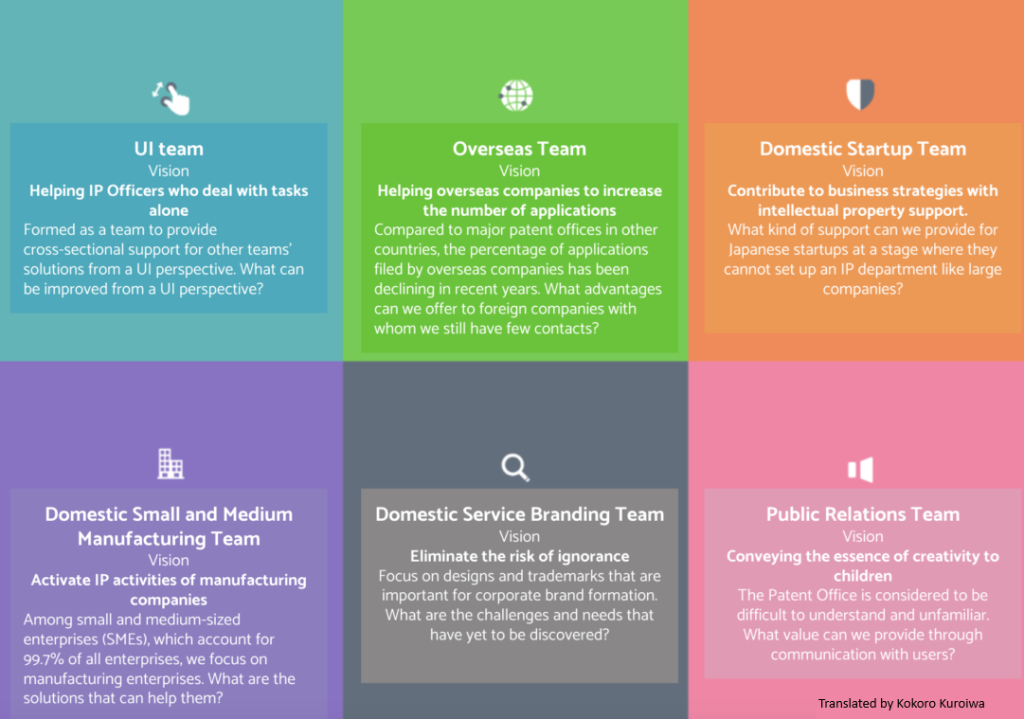Motivation
In a world where creativity is at an all-time high, why do so many groundbreaking ideas fail to make a real-world impact? The truth is, the journey from invention to innovation is often more challenging than it seems. Many brilliant ideas never fully realize their potential because they fail to transition into practical, market-ready solutions. For Japan—a nation renowned for its high-quality manufacturing and cutting-edge technology—this disconnect is becoming a critical concern.

The issue lies not in the lack of ingenuity, but in the difficulty of aligning industrial strengths with the rapidly evolving values and expectations of today’s diverse market. Japanese industry is globally recognized for its high quality, functionality, and strong field capabilities, often driven by top-down structures. However, this approach does not always accommodate the various values, needs, and user experiences that dominate today’s consumer-centric, IoT- and AI-driven era.

Innovation (applied improvement) is often mistakenly viewed as the natural result of invention (discovery of something new), yet many breakthroughs remain just that—ideas without practical application. The Japan Patent Office (JPO), responsible for managing industrial property rights, noticed a troubling trend: while patent applications continue to surge, design registrations, which are more closely tied to user-centric innovation, have stagnated. This imbalance threatened to stifle Japan’s economic growth and global competitiveness.
The Project
A way to align industrial strength with changing market demands and make the JPO more user-oriented and user-friendly was needed. To achieve this, a project was created, to integrate design driven management and design thinking into the JPO therefore lead as an example for other companies to change as well. The project was not just about improving design practices—it was about reshaping the relationship between industry and market, ensuring that Japan’s technical strengths evolve together with societal needs.

To address the various aspects, six specific subprojects have been launched, each focusing on different target groups and needs. In total, the JPO worked out 6 key considerations and designated a team of about 10 people to each of them. These subprojects include:
- User Interface Team
- Supported isolated intellectual property (IP) managers by providing cross-functional assistance from a user interface (UI) perspective.
- Overseas Team
- Assisted foreign countries to increase the number of IP applications.
- Domestic Startup Team
- Helped small businesses and young enterprises that may lack intellectual property departments to manage patents and trademarks.
- Domestic small and medium enterprises (SMEs) and manufacturing Team
- Provided special support for SMEs in the manufacturing area, which account for 99.7% of all businesses in Japan.
- Domestic service and branding team
- Worked to reduce the risks of unrecognized intellectual property
- Addressed challenges such as why companies fail to apply for trademarks and how to raise awareness about the importance of these applications.
- Public Relations Team
- Promoted the significance of creativity and IP to children and young people in an accessible way.
- Aimed to foster a stronger public perception of IP, especially among younger generations, to drive future innovation.
Approach
To identify challenges and develop tools to overcome them, the Double Diamond model was used as a structured approach.
The model consists of alternating diverging and converging phases:

- The first phase focuses on gathering as much information as possible by interviewing customers.
- In the second phase, the collected information is analyzed, filtered, and synthesized into specific challenges that need to be addressed.
- The third phase diverges again, this time to explore and develop potential solutions for the identified problems.
- Finally, in the fourth phase, these solutions are tested with customers to determine the most effective ones.
After all the phases have been completed, it is possible for the team to return to the first phase and start the next iteration.
Results
Over a span of six months, 240 users were interviewed, 59 ideas were developed, and 12 of them were selected for implementation. The following results highlight key insights from the project:
User Interface Team
Challenge
- When faced with a “Notice of Reason for Rejection,” IP managers often struggled to determine the next steps due to a lack of legal knowledge and limited budgets to hire attorneys or agents.
Solution:
- A new System was introduced that provides a step-by-step guide on how to respond. It includes explanation of legal terms, example responses, and ready-to-use templates, making the process more accessible.
Overseas Team
Challenge:
- Many IP managers from European and American companies are unfamiliar with Japan’s IP regulations and practices, making it difficult to communicate their objectives and engage in direct interactions.
- A structured and efficient way to acquire necessary information and seek assistance was needed.
Solutions:
- By collaborating with legal professionals, structured programs were developed to simplify the process. Additionally, tailored content has been created, to specifically support European and American IP managers, ensuring better accessibility and understanding.
Domestic Startup Team
Challenge:
- Startups looking to hire professionals often have difficulties finding the right staff, who understand their business and can provide strategic IP advice.
Solution:

- A new matching platform has been introduced to help startup CEOs connect with IP professionals. This platform provides mentorship and specialized support, helping startups find the right staff and make informed IP decisions.
Domestic small and medium enterprises (SMEs) and manufacturing Team
Challenge:
- The initial target users of the JPO (small subcontracting business owners) were too busy with daily operations to engage in long-term strategic planning.
Solution:
- By shifting the focus to manufacturing SMEs who already explore new business opportunities, the team was able to provide tailored IP strategy support. This approach proved to be far more effective in driving innovation and business transformation.
Domestic service and branding team
Challenge:
- Many business owners are unaware of the benefits of trademark registration. IP is rather seen as cost instead of investment, which can pose significant risks, such as disputed over business names. This can particularly impact small businesses.
Solution:
- Instead of using a traditional, information-heavy approach, the team created an engaging Video that presents real-world examples of trademark related business in a relatable way. Link to the video
Public Relations Team
Challenge:
- Children and artisans struggle to connect with people outside their own perspectives and lack opportunities for discovery, experimentation, and innovation.
Solution:
- The team redesigned intellectual property education by integrating it into hands-on creative workshops. They also involved industry professionals early in the development process, making learning more interactive, collaborative, and relevant to real-world innovation.
Impact
As a result of the project, the number of design applications increased from 31,406 in 2018 to 32,525 in 2021, 3 years after its initiation. A survey from 2018 (Vivivit & Inc., 2018) revealed that although only 14.9% of companies implemented design-driven management, 73.8% of them observed improvement in sales and profits.
Furthermore, in 2022, the Research Institute of Economy, Trade, and Industry introduced a Key Performance Indicator designed to assess the impact of design-driven management on business outcomes. This suggests that design thinking and design-driven management are playing an increasingly important role in the Japanese economy — possibly also influenced by the JPO’s design project.
These results suggest that adopting design thinking for management proved successful.
Sources
This is Design Thinking. (n.d.). Japan Patent Office strives to bridge invention and innovation through design-driven management. Retrieved April 1, 2025, from https://thisisdesignthinking.net/…
Japan Patent Office (JPO). (n.d.). Trademark Fist: The Secret Technique to Protect Your Business. Retrieved April 4, 2025, from https://www.jpo.go.jp/introduction/soshiki/design_keiei/shohyoken/index.html
Japan Patent Office (JPO). (2019). Official report of the project. Retrieved April 4, 2025, from https://www.jpo.go.jp/introduction/soshiki/document/design_keiei/report_20190404.pdf
IP BASE. (n.d.). Resulting matching platform of the Domestic Startup Team. Retrieved April 4, 2025, from https://ipbase.go.jp/
Vivid & Inc. (2018). Survey on corporate awareness regarding “Design Management” and “Design Thinking”. Retrieved April 4, 2025, from https://vivivit.co.jp/…
Japan Patent Office (JPO). (2024). JPO Status Report 2024. Retrieved April 4, 2025, from https://www.jpo.go.jp/…
Pictures
Yellowslice. (n.d.). Double Diamond Model: How to implement the process for real. Retrieved April 3, 2025, from https://yellowslice.in/…
The gap between Invention and Innovation, generated by https://chatgpt.com/
6 Teams of the JPO project – Translated by Kokoro Kuroiwa.
Original at report_20190404.pdf
Japan Patent Office (JPO). (n.d.). Trademark Fist: The Secret Technique to Protect Your Business. Retrieved April 4, 2025, from https://www.jpo.go.jp/introduction/soshiki/design_keiei/shohyoken/index.html
IP BASE. (n.d.). Resulting matching platform of the Domestic Startup Team. Retrieved April 4, 2025, from https://ipbase.go.jp/
Two challenges the Japanese industry faces in the current market Retrieved April 7, 2025, from https://www.jpo.go.jp/introduction/soshiki/design_keiei/shohyoken/index.html



